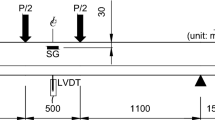Abstract
An innovative approach to increase structural survivability of concrete and maintain structural durability of concrete was developed in case of earthquakes and typhoons. This approach takes advantage of the superelastic effect of shape memory alloy(SMA) and the cohering characteristic of repairing adhesive. These SMA wires and brittle fibers containing adhesives were embedded into concrete beams during concrete casting to form smart reinforced concrete beams. The self-repairing capacity of smart concrete beams was investigated by three-point bending tests. The experimental results show that SMA wires add self-restoration capacity, the concrete beams recover almost completely after incurring an extremely large deflection and the cracks are closed almost completely by the recovery forces of SMA wires. The number or areas of SMA wires has no influence on the tendency of deformation during loading and the tendency of reversion by the superelasticity. The adhesives released from the broken-open fibers fill voids and cracks. The repaired damage enables continued function and prevents further degradation.
Similar content being viewed by others
References
DRY C. Matrix cracking repair and filling using active and passive modes for smart timed release of chemicals from fibers into cement matrices [J]. Smart Materials and Structures, 1994, 3(2): 118–123.
DRY C. Smart earthquake-resistant materials: Using time-released adhesives for damping, stiffening, and deflection control [C]//SPIE. Proceedings of SPIE. Lyon, France: SPIE, 1996: 958–967.
DRY C. Three designs for the internal release of sealants, adhesive, and waterproofing chemicals into concrete to reduce permeability [J]. Cement and Concrete Research, 2000, 30(2): 1969–1977.
VICTOR C L, YUM M L, CHAN Y W. Feasibility study of a passive smart self-healing cementitious composite [J]. Composites (Part B), 1998, 29(6): 819–827.
OU Jin-ping, KUANG Ya-chuan. Experiments and analysis of concrete material with crack self-repairing performance using embedded capsules filled with adhesive [J]. Acta Mechanical Solida Sinica, 2004, 25(3): 320–324. (in Chinese)
KUANG Ya-chuan, OU Jin-ping. Experiments and analyses of the self-healing of cracks in reinforced concrete beams with embedded fibers filled with adhesive [J]. China Civil Engineering Journal, 2005, 38(4): 53–59.
KUANG Ya-chuan, OU Jin-ping, LI Dong-sheng. Experimental research on concrete material with crack self-repairing performance using embedded fibers filled with adhesive [J]. Journal of Building Structures, 2006, 27(S): 107–112. ( in Chinese)
KUANG Ya-chuan, OU Jin-ping. Research and progress of concrete materials with crack self-repairing ability as biomaterials [J]. Advances in Mechanics, 2006, 36(3): 406–414. (in Chinese)
YUJI S, YOSHIKAZU K, TOSSHIBUMI F, MASANORI I. Experimental study on enhancement of self-restoration of concrete beams using SMA wire [C]// SPIE. Proceedings of SPIE. Bellingham, USA: SPIE, 2003:178–186.
MA Huai-zhong. Application of shape memory alloy to the structural deformation and control of the crevice [J]. Journal of Northwest Institute of Light Industry, 1998, 16(3): 120–125. (in Chinese)
SUN G J, SUN S S, XU X D, WU J S. A study on the thermomechanical deformation of elastic beam with embedded shape memory alloy wires [J]. Materials and Deign, 2000, 21(6): 525–528.
SUP C, JUNG J L. The shape control of a composite beam with embedded shape memory alloy ire actuators [J]. Smart Materials and Structures, 1998, 7(5): 759–770.
ARUP K M, IHOSVANY N. Smart prestressing with shape-memory alloy [J]. Journal of Engineering Mechanics, 1998, 124(10):1121–1128.
LI Hui, LIU Zhi-qiang, OU Jin-ping. Study on damage emergency repair performance of a simple beam embedded with shape memory alloys [J]. Advances in Structural Engineering, 2004, 7(6): 495–502.
WILDE K, GARDONI P, FUJINO Y. Base isolation system with shape memory alloy device for highway bridges [J]. Engineering Structures, 2000, 22(1): 222–229.
DESROCHES R, DELEMONT M. Seismic retrofit of simply supported bridges using shape memory alloys [J]. Engineering Structures, 2002, 24(3): 325–332.
SHIBA K, MASE S, YABE Y, KAZUO T. Active/passive vibration control systems tall building [J]. Smart Materials and Structures, 1998, 7(5): 588–598.
CHEN Gui-jun, ZHU Wei-jun, QIANG Shi-kun. Microstructure and super-elasticity behavior of NiTi alloy [J]. Steel Wire Products, 2003, 29(3): 2–5. (in Chinese)
CUI Li-shan, QI Min, SHI Ping, CHEN Fei-xia, YANG Da-zhi. Output of stress and strain for NiTi shape memory alloy wires [J]. Journal of Functional Materials and Devices, 1996, 2(2): 78–82. (in Chinese)
PLIETSCH R, EHRLICH K. Strength differential effect in pseudoelastic NiTi shape memory alloys [J]. Acta Materialia, 1997, 45(6): 2417–2424.
Author information
Authors and Affiliations
Corresponding author
Additional information
Foundation item: Project(50538020) supported by the National Natural Science Foundation of China; Project(20070421050) supported by China Postdoctoral Science Foundation
Rights and permissions
About this article
Cite this article
Kuang, Yc., Ou, Jp. Passive smart self-repairing concrete beams by using shape memory alloy wires and fibers containing adhesives. J. Cent. South Univ. Technol. 15, 411–417 (2008). https://doi.org/10.1007/s11771-008-0077-9
Received:
Accepted:
Published:
Issue Date:
DOI: https://doi.org/10.1007/s11771-008-0077-9




